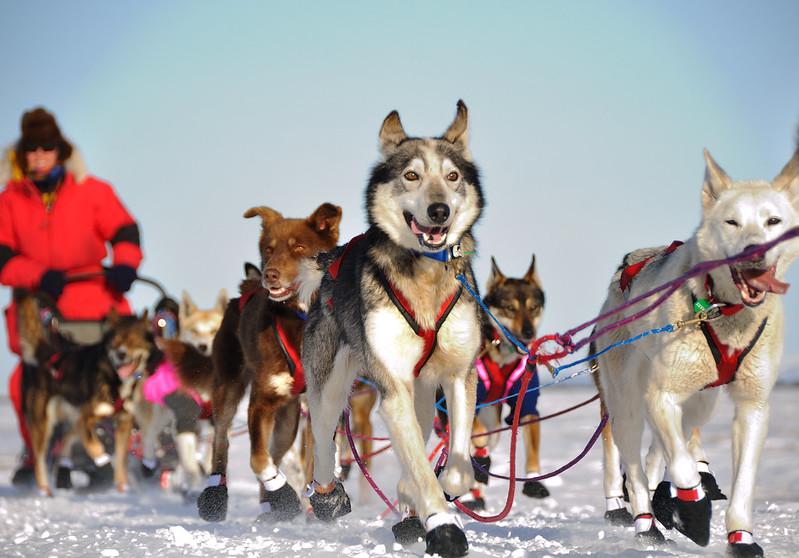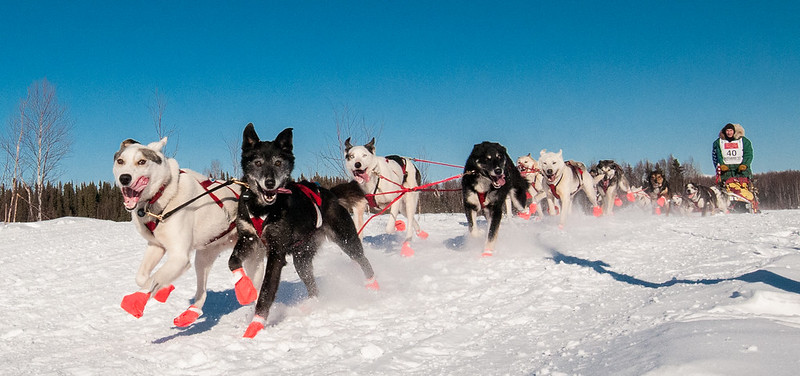Iditarod Trail Sled Dog Race
Alaska’s Ultimate Challenge of Spirit and Adventure
2026/03/06 - 2026/03/18
Every March, the sound of dogs’ paws and the creak of sled runners echo across Alaska’s vast wilderness, as bundled spectators cheer on the legendary “Last Great Race on Earth.” The Iditarod Trail Sled Dog Race covers roughly 1,600 km from Anchorage to Nome, where mushers and their dog teams battle blizzards, mountains, and endless northern nights. For adventurers, dog lovers, and those drawn to the romance of the North, the Iditarod is a celebration of courage, tradition, and Alaska’s wild beauty.
The race starts on the first Saturday of March, drawing competitors and fans from around the world. Whether at Anchorage’s ceremonial start, cheering at remote checkpoints, or celebrating at the finish in Nome, every moment offers a taste of Alaska’s unique thrill and wonder.
Main Attractions
Ceremonial Start in Anchorage
Downtown Anchorage transforms into a festival: excited dogs bark, mushers wave, and the streets are lined with banners and snow sculptures. The aroma of hot chocolate, reindeer sausage, and woodsmoke fills the air as the crowd’s cheers ring out.
Events Along the Trail
Each checkpoint becomes a mini-festival as the race progresses. Locals offer warm food and encouragement, and in Nome, cowbells ring and fireworks light up the sky as finishers arrive. The whole town stays up to welcome every musher, creating a sense of unity unique to Alaska.
Costumes and Decorations
Spectators and volunteers bundle up in colorful parkas, fur hats, and snow boots. Some wear handmade husky ears or sled dog-themed face paint. Sleds are decorated with sponsor logos, flags, and lucky charms, while Anchorage and Nome are adorned with banners, ice sculptures, and lights.
Traditional Food & Drink
Festival-goers enjoy Alaskan favorites like reindeer sausage, smoked salmon chowder, sourdough pancakes, and fry bread. Hot chocolate, coffee, and local craft beer are popular, and in Nome, finishers are toasted with Alaskan vodka or whiskey.
Cultural and Historical Background
The Iditarod’s roots run deep in Alaska’s harsh environment and the lives of its people. For centuries, Alaska Natives used dog sleds for travel and transporting goods. During the Gold Rush in the late 19th century, dog sleds became essential for moving miners, mail, and supplies across the vast, roadless wilderness. Mushers often competed to prove the strength and speed of their teams, and in 1908, Nome hosted the first organized dog sled race, the All Alaska Sweepstakes, marking the start of modern sled dog racing.
The defining moment came in 1925, during the “Nome Serum Run.” When a diphtheria outbreak threatened the town of Nome, airplanes couldn’t fly due to extreme weather, so the only hope was a relay of dog sled teams. Twenty mushers and about 150 dogs transported life-saving serum over roughly 1,000 km in just five to six days, saving hundreds of lives. This heroic feat became legendary, symbolizing the courage and teamwork of mushers and their dogs, and the Iditarod Trail itself was the route used for this relay.
As airplanes and snowmobiles replaced dog sleds, the tradition began to fade. To honor this history and preserve the mushing culture, the first Iditarod Trail Sled Dog Race was held in 1973. The race follows the historic mail and supply route from Anchorage to Nome, covering about 1,600 km over 10 days to two weeks. The Iditarod is more than a sport—it’s living history, connecting Alaska’s pioneering past, Native culture, survival wisdom, and the deep bond between humans and dogs. It unites villages along the trail, brings communities and fans together, and stands as Alaska’s greatest winter celebration.
Participant Voices
At the start in Anchorage, I was swept up in the energy of the dogs and the crowd. One musher told me, “The Iditarod is a world where it’s just you, your dogs, and nature.” Listening to the dogs breathe under the northern lights was pure magic—nothing else compares.
Fun Facts
- The course is about 1,600 km (1,049 miles), but the distance and route change each year.
- Teams start with 14–16 dogs and must finish with at least five.
- The fastest teams finish in 8–9 days; others may take over two weeks.
- The race is named after the historic mail and supply route, the Iditarod Trail.
- Mushers are required to carry an axe, snowshoes, cooker, and dog booties as mandatory gear.
Festival Dates
The Iditarod Trail Sled Dog Race is held every March from Anchorage to Nome.
The event schedule is subject to change. Please check the official website for the most up-to-date information.
Information
| Name | Iditarod Trail Sled Dog Race |
| Country | United States |
| Area | Alaska, Anchorage |
| Date | 2026/03/06 - 2026/03/18 |
| Link |
Upcoming Festivals
Whirling Dervishes Festival Turkey
A Mesmerizing Dance of Divine Love
2025/12/06Mevlana Celaleddin Rumi Commemoration Ceremony ( Şeb-i Arus ) Turkey
A Whirling Journey to Divine Love
2025/12/10Dia de la Virgen de Guadalupe Mexico
A Festival Weaving Faith, Fervor, and Mexican Identity
2025/12/11L'Escalade Switzerland
Geneva’s Grand Winter Festival of Courage, Chocolate, and Community
2025/12/12Umkhosi Wokweshwama South Africa
The Zulu First Fruits Festival—A Sacred Celebration of Land, Ancestors, and Renewal
2025/12/12Lucia Festival (St. Lucia's Day) Sweden
A Festival of Light Illuminating the Nordic Darkness
2025/12/15Las Posadas Mexico
The Luminous Quest for Sacred Shelter
2025/12/22Noche de Rabanos (Night of the Radishes) Mexico
A celebration blending art, farming heritage, and cultural traditions
2025/12/23Chant of the Sybil on Majorca Spain
A Medieval Prophecy Echoes Through Majorcan Christmas
2025/12/23‘Hatajo de Negritos’ and the ‘Hatajo de Pallitas’ Peru
A Christmas Festival of Rhythm, Faith, and Afro-Andean Heritage in Peru’s Ica Region

